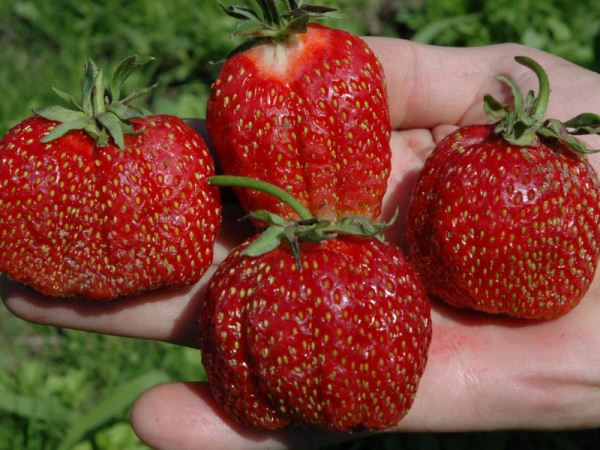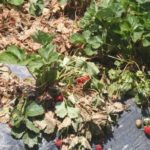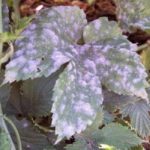Festival Strawberry is a popular variety of garden berries, bred back in the 50s of the last century. Despite its age, the variety is still a favorite among many gardeners. Festival belongs to unpretentious varieties, has a special taste and aroma, as well as a number of other advantages, with a description of which we will read below.
Table of contents
Description Strawberry Festival Chamomile
This variety is considered one of the best among the strawberries of the average ripening period.The variety was bred in the last century by the well-known breeder Yu. K. Katinskaya, by cross breeds Abundant and Premier.
The plant has tall compact bushes. Peduncles dense and strong, which allows you to easily keep a fairly rich harvest. They are located almost at the level of leaves or slightly lower. Such a structure provides the fruits with good ventilation and warming by the sun. In addition, the berries are perfectly visible, so they are easy to collect. The flowers on the bushes are bisexual.
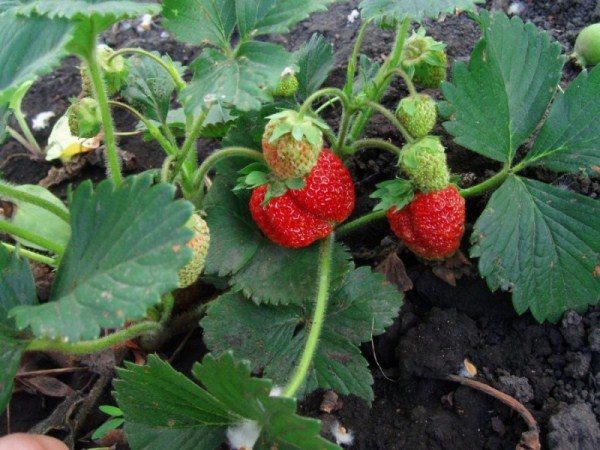
Fruit ripening occurs in early July.however, in the northern regions this period occurs later. Differs variety of long-fruiting. Sometimes berries can appear until late autumn. The variety has high and regular yield. The first berries ripen fairly large - up to 50 g. Subsequent fruits will be smaller, around 20 g. The color is saturated red, glossy. Form - conical, slightly flattened, with small grooves.
The flesh is bright pink, medium density, juicy, tender, very pleasant to the taste. The peduncle is easily separated, therefore, when harvested, the fruits are not injured, remain dry and clean. One medium sized berry contains approximately 7% Sahara, 1,4% acids, and vitamin C - about 90 mg. Another distinctive feature is a delicious, pronounced aroma.
The main advantages of the variety:
- Elegant berries with excellent taste characteristics.
- High regular yieldwith a long fruiting period.
- Resistant to frost and drought, therefore suitable for cultivation in different regions.
- Good transfers transportation.
- Rarely exposed diseases.
Of disadvantages weak resistance to diseases such as powdery mildew and verticillary wilt can be noted.
How to get seedlings of this variety
To get a good harvest, it is necessary to provide high-quality planting material. It can be purchased from private sellers or in specialized stores. When choosing seedlings should pay attention to the following points:
- Sapling must have not less 3 leaflets.
- Leaves without signs of disease, pest damage and other visible damage.
- The core is alive, not dry and not rotten.
- Root neck strong enough without rot and stains.
- Healthy root systemNot dry, well developed.
Good seedlings can also be obtained independently.
From seed
To this end, in late February, early March, they sow seeds. Since they are small and germinate well with light, they need to be decomposed on the surface of the moistened soil.. So that they do not fall into the soil, the top layer can be sprinkled with a small layer of sand. Then the seed container needs to be covered with a film in order to keep the moisture longer.
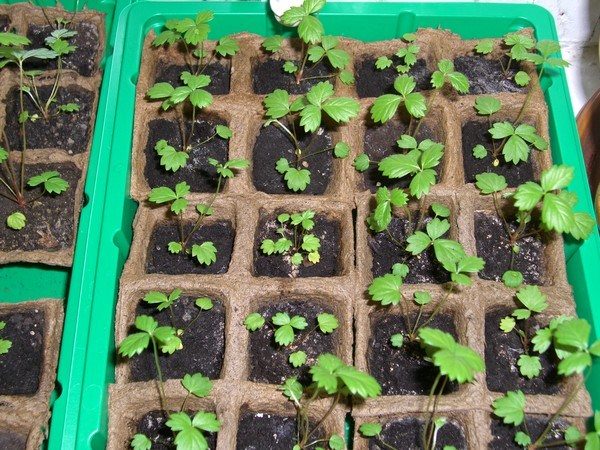
Through 10-14 days seedlings will appear. When the seedlings will have the first two leaves, they need to dive. For this transplant in a suitable container, well buried roots in the soil. This should be done carefully. As a rule, plants are well tolerated by a picking.
In the landing tank seedlings are grown until mid-June. Then transplanted into the open ground. Harvest saplings will give only for next year.
Mustache breeding
In the bushes that bear fruit, whiskers are necessarily removed. Since this takes away their power,in consequence of which the yield is reduced. Therefore, for the cultivation of seedlings is recommended to choose individual bushes, and from the rest to harvest. To mustache grew actively in the uterine bushes clean flower stalks. For reproduction, a strong healthy bush is selected, on which five antennae should be left.
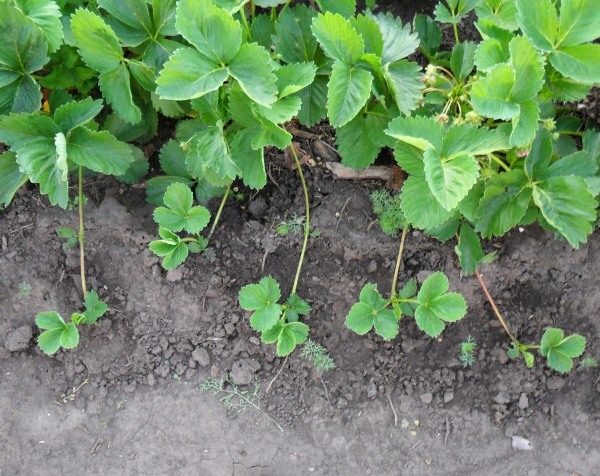
When the socket appears on the whisker, it must be fastened to the ground (it can be wire), slightly buried, and wait for the roots to appear. It is necessary to separate the seedling from the uterine bush when it is already sufficiently rooted.. The harvesting of seedlings for the next year is carried out at the end of November. Seedlings are placed in a dark cool place and stored until early spring.
Soil preparation for planting
Strawberry is a thermophilic plant, loves the sun. It is not recommended to plant it in too wet places and lowlands.. Shaded areas should also be excluded. In the shade, as a rule, excess moisture is formed, so the plant can be exposed to fungal diseases.
Strawberry unpretentious to the type of soil. The exception is too clay or sandy soil. This soil can be diluted with the introduction of humus. So it will become more saturated and friable.
When the landing area is selected, it should be prepared. The place needs to be freed from weeds, especially from their roots. Then organic fertilizers are applied (chicken manure, cow dung), the site is dug up and leveled.
Planting strawberries Festival
It is possible to land plants in the single-row and double-row way. In the first case, distance between rows is 60 cm, and between seedlings 20 cm. This landing is recommended for spring and autumn planting. In the first year, strawberries do not bear fruit, but tendrils into the space between rows.
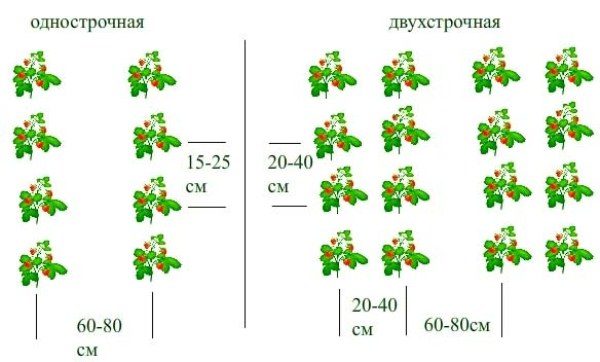
Planting in the double-row way, is considered more effective, well is suitable for the spring period. Seedlings are arranged among themselves through 15 cmbetween rows - through 30 cmbetween tapes - 70 cm. You can plant bushes among themselves even more densely. This will save the rows from seedlings that did not bloom in the first year of growth or were subject to disease. By removing unsuitable seedlings, there will be free space for healthy plants.
Planting of this variety is carried out in the spring (beginning of April) or in the fall (beginning of September). Since the Festival needs a sufficiently moist soil for healthy development, it is not recommended to plant in the summer. The optimal length of the roots of seedlings for planting - 8-9 cm.
Before planting, shallow holes or furrows are made, thoroughly moistened. The roots of the bushes should be well straightened and lowered into the hole in an upright position.. Gently sprinkle with earth, a little rammed. Then water again and cover the soil under the bush with a layer of mulch, suitable humus or straw. This will prevent the emergence of a large number of weeds and retain moisture.
Garden Berry Care
The care of the Festival bushes is as follows:
- Watering. It is recommended to carry out depending on the drying of the soil. Watering is better in the early morning. While there is no color, water in the form of a shower can be poured on the leaves of the plant. When the color and berries appear, you need to water under the bush. On hot days, the irrigation procedure is carried out 2 times a week. With the advent of fruit, watering is reduced.
- Weeding and Loosening. Weeding should be carried out as weed appears.You should not allow severe contamination of the beds, as the weeds take nutrients and moisture from the soil. After harvesting the weeds, the soil needs to be pierced so that it breathes.
- Fertilizer. The process of feeding is carried out in spring and autumn. In the period of flowering and fruiting fertilizer is not recommended. For fertilizing, you can use organic matter (cow dung, chicken manure, humus) or special mineral fertilizers that are sold in stores.
Like any cultivated plant, strawberries can be attacked by pests. If this happens, treatment is necessary. Processing can be done before flowering and after picking the fruit.
Pests
- Transparent tick. It affects the foliage, as a result, the leaves turn yellow, and the berries become small. After harvesting the berries, the plants need to be treated with karbofos.
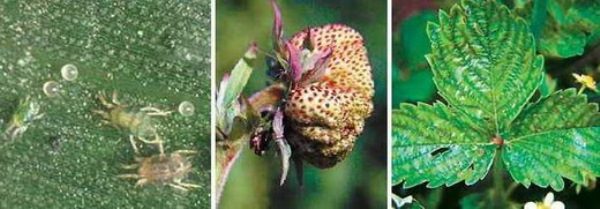
- Nematodes. Located in the foliage and hit the bushes completely. Strawberries stop growing. Such diseased plants need to be removed from the garden.
- Ants. They spoil the fruits of plants. To remove them, you need to sprinkle the earth near the bushes with soda.
- Slugs, snails. They love to taste sweet berries.If they are many, they can completely destroy the crop. You can deal with them with the help of special purchased products. You can also around the perimeter of the beds to make a fence of prickly branches or shells. Such a barrier is difficult for slugs to overcome. Also clams are afraid of soda.
In order to prevent, in the fall, the soil is treated with disinfectants. In a timely manner, it is necessary to clean dry leaves and control the soil moisture.
Diseases
Diseases of strawberries are:
- Mealy dew. The plant is covered with a grayish bloom, the fruits begin to mold. To prevent disease, it is necessary to spray bushes with soda solution before the beginning of color.
- Verticillary wilting. Dark-colored spots first appear on the leaves, then the leaves begin to die off. The plant looks withering, and soon completely perishes. Infected bushes must be removed from the garden in time and burned so that the disease does not spread.
- Verticillous wilting of strawberries
- Festival Strawberry bush is struck with powdery mildew
Also in the care of strawberries include preparing it for the winter. The first bushes need to pile up. It is better not to do weeding in order not to damage the roots.
Suitable for this purpose: straw, foliage, spruce, spruce branches, vine. From synthetic materials it is possible to use agrofibre. Preparation should be carried out before the onset of frost.
Growing strawberries varieties Festival chamomile - the process is simple. But still, to get a good harvest of delicious berries, it is necessary to provide the plants with proper care.
